Japanese coffee jelly is a tasty dessert that is easy to make with just a few simple ingredients. It found widespread popularity in Japan and is now a common menu item in cafes and convenience stores. The subtle bitter sweetness of the coffee jelly paired with some fresh whipped cream makes it a refreshing and delicious chilled dessert!
Table of contents
What is Japanese coffee jelly
Coffee Jelly, or kohii zerii, is a popular dessert amongst adults in Japan for its bitter sweet taste. It is made by chilling coffee with a coagulant agent such as gelatin and agar-agar. Many people believe that this dessert originated in Japan; however, it was actually first made in England in the 1800s. The British recipe called for brewed coffee to be mixed with gelatin and left to set in cups or a mold. It was later introduced and made popular in Japan in the 1960s by a Japanese coffee shop chain. Although it lost popularity in the US and UK, jelly desserts are well-liked in Japan so coffee jelly lives on! It is now a common Japanese dessert you will find in cafes, restaurants, and convenience stores across the country. But it’s very simple to make at home yourself with just a few ingredients.
What do you need?
Setting agents : The texture of the jelly depends on the ratio of total amount of liquid and setting agent and also the type of setting agent used. Choose one according to your liking of jello texture. However, a harder jello texture will have a lighter taste of coffee and a softer jello means a stronger taste of coffee. This is because as the amount of gelatin decreases, the concentration of coffee increases. I used kanten to make this coffee jelly.
– Gelatin powder is made from collagen contained in animal bones and skins. It melts at 50 – 60°C and sets at below 20°C. The texture of the jello will be light and jiggly as the jello will start to melt when you put it in your mouth.
– Agar agar powder is made from fibre extracted from seaweeds and it will melt at over 90°C and harden in room temperature at 30-40°C. The texture will be smooth and soft.
– Kanten is a meat-free substitute for gelatin powder. It is made from an edible seaweed which makes it suitable for vegans and vegetarians. Kanten sets at room temperature.
Coffee: There are different coffee options you can use.
– Instant coffee – I recommend using instant coffee because it is easy to adjust the strength of coffee to your liking. Where possible, use fresh instant coffee to avoid using over oxidised coffee.
– Espresso – you can also use real coffee too if you prefer for a richer and stronger coffee flavor. Choose deep roasted coffee beans for a cleaner taste. Also use deep roasted coffee powder if you use a coffee drip.
– Decaf coffee- using coffee makes this dessert contain caffeine. If you’d like a caffeine free option, use decaf coffee.
Whipped cream – In Japan, coffee jelly from convenience stores or supermarkets often comes with fresh cream attached. It is called “furesshu” and is provided for you to pour over the coffee jelly. Whipped cream or vanilla ice cream balances the acidity of the coffee and provides a fresh and light component.
Water
How to make Japanese Coffee Jelly?
This coffee jelly recipe is for how to make coffee jelly using kanten. For instructions on using gelatin, check the recipe card.
- Pour water in a small pot over medium-high heat and sprinkle in the kanten. Bring it to boil then turn the heat down to low. Simmer for 1-2 minutes to ensure the kanten has dissolved.
- Add sugar and coffee and stir with a spoon or whisk to dissolve. Pour the mixture into your desired cup or mold. Let it chill in the fridge to set.
- Once set, remove from the mold and cut into cubes or serve directly set in the cup. Add some fresh cream
What to eat coffee jelly with
Coffee jelly in Japan is typically served in a small dish/cup and is usually accompanied with whipped cream or milk. You can serve it set in the cup as is or chop it into cubes or remove from a mold and place in a bowl. Offset the bitter and astringent coffee taste with some creaminess by topping the jelly with whipped cream or ice cream or pour over some milk to create a refreshingly chilled dessert. It also pairs nicely with chocolate if you wish to garnish it with some chocolate syrup, chocolate shavings or chocolate powder.
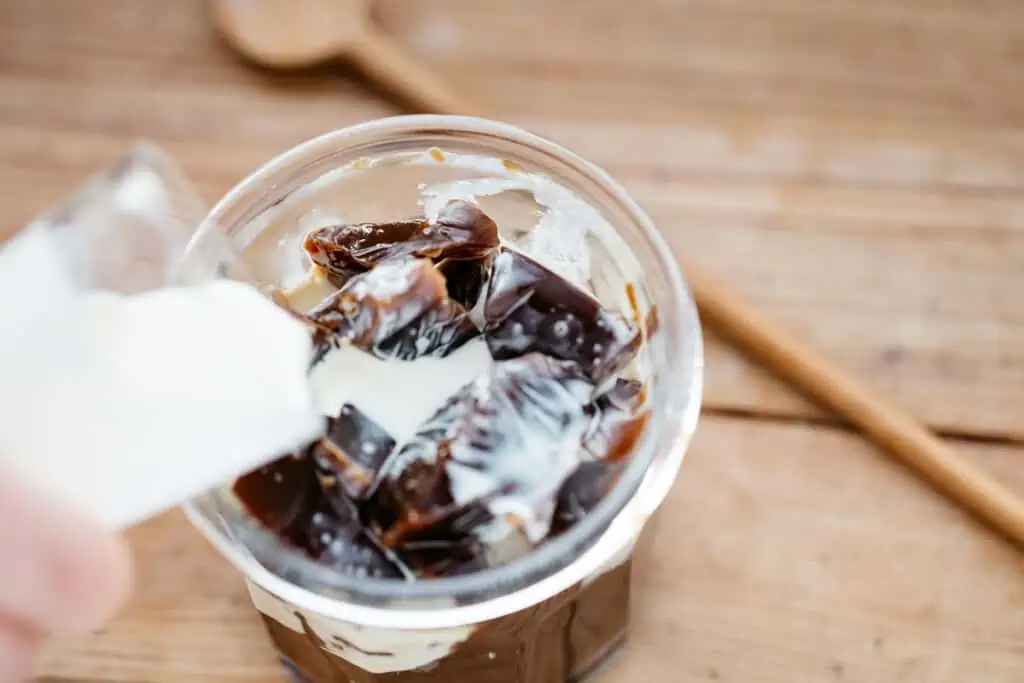
Tips for Making Japanese Coffee Jelly
- No matter which type of coffee you use, make it stronger than what you would normally drink. This is because the strength will be weakened when mixed in a kanten/gelatin mixture. Use 1 tablespoon of instant coffee for 1 cup water. If you brew your coffee, use deep roasted coffee beans.
- If you use gelatin powder, pour the gelatin powder over the water (not the powder first) otherwise it will be lumpy and clumped together.
- Different setting agents (gelatin, kanten, agar) will all have different textures. Choose one depending on the texture you like. Gelatin and agar agar will have a softer and more jiggly texture while kanten will be more firm.
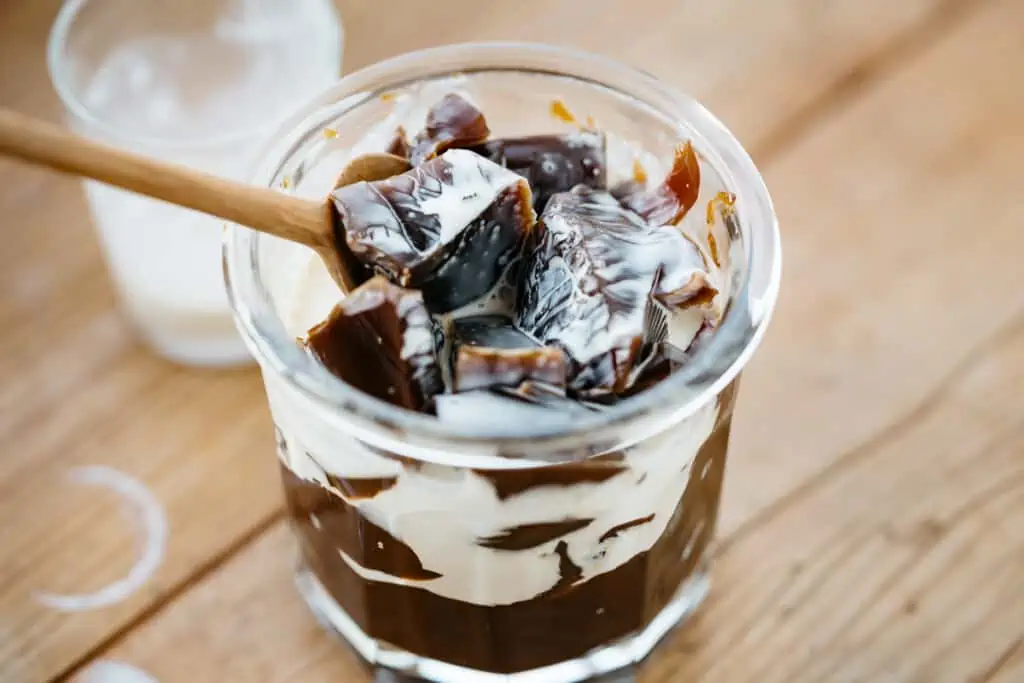
FAQ
A: It will last about 1-2 days in the fridge. If you use kanten it becomes very hard the longer you leave it in the fridge.
Related Recipes
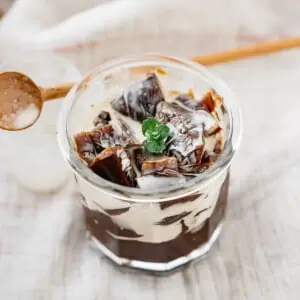
Japanese Coffee Jelly
Ingredients
- 2 cups water
- ½ stick Kanten Powder *1
- 2 tbsp Instant Coffee
- 1 tbsp sugar *2
- ¼ cups whip cream *3 optional
Instructions
- Pour water in a small pot over medium-high heat and sprinkle the kanten in.
- When it boils, turn the heat down to low and simmer for a further 1-2 minutes to ensure the kanten has dissolved.
- Add sugar and instant coffee and stir with a spoon or whisk to dissolve. Pour the mixture into your desired cup or mold.
- Let it chill in the fridge to set.
- Once set, remove from the mold and cut into cubes or serve directly set in the cup.
- Pour fresh whip cream over the jelly to serve.

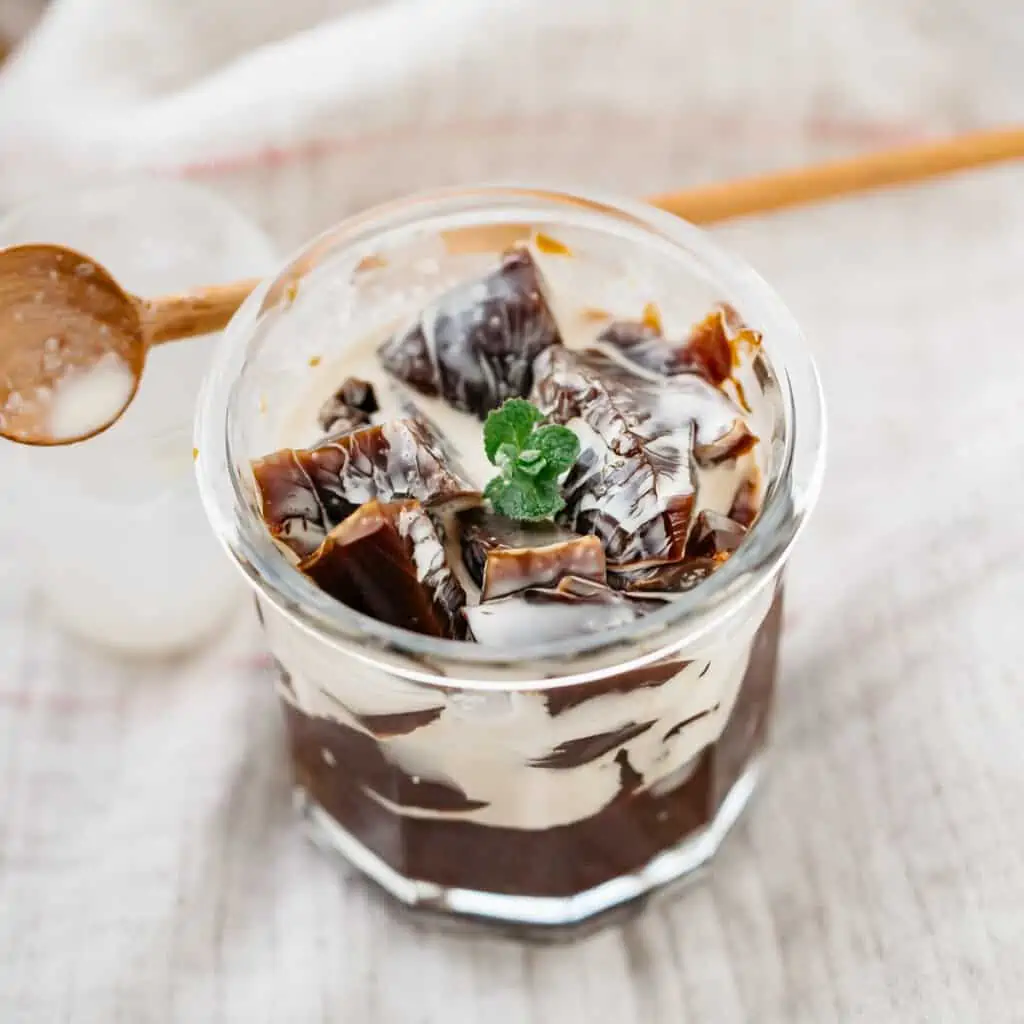
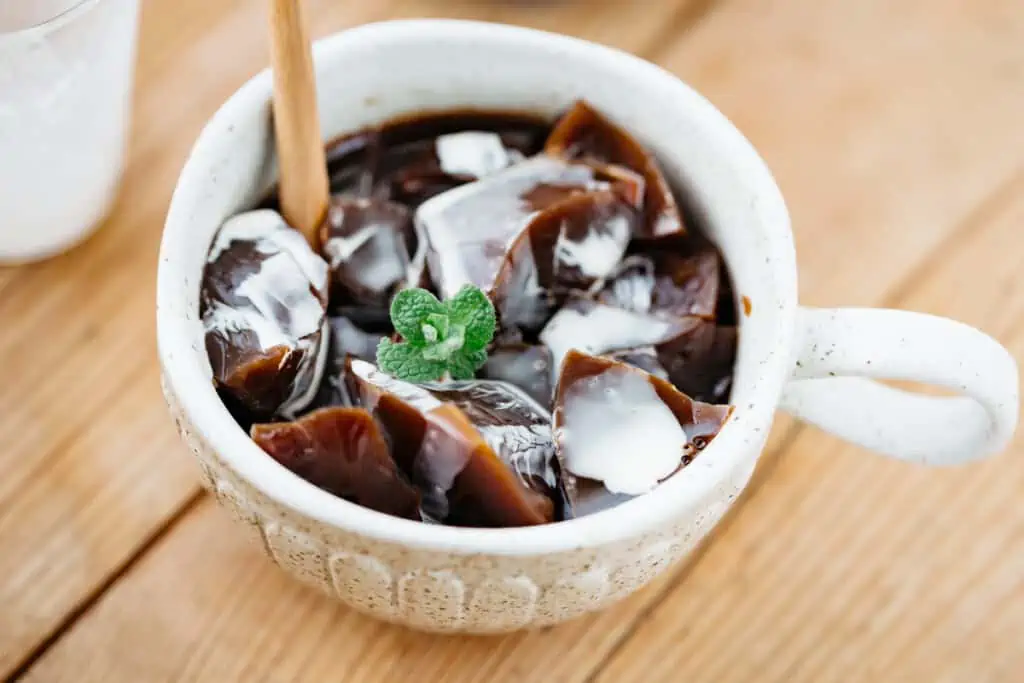
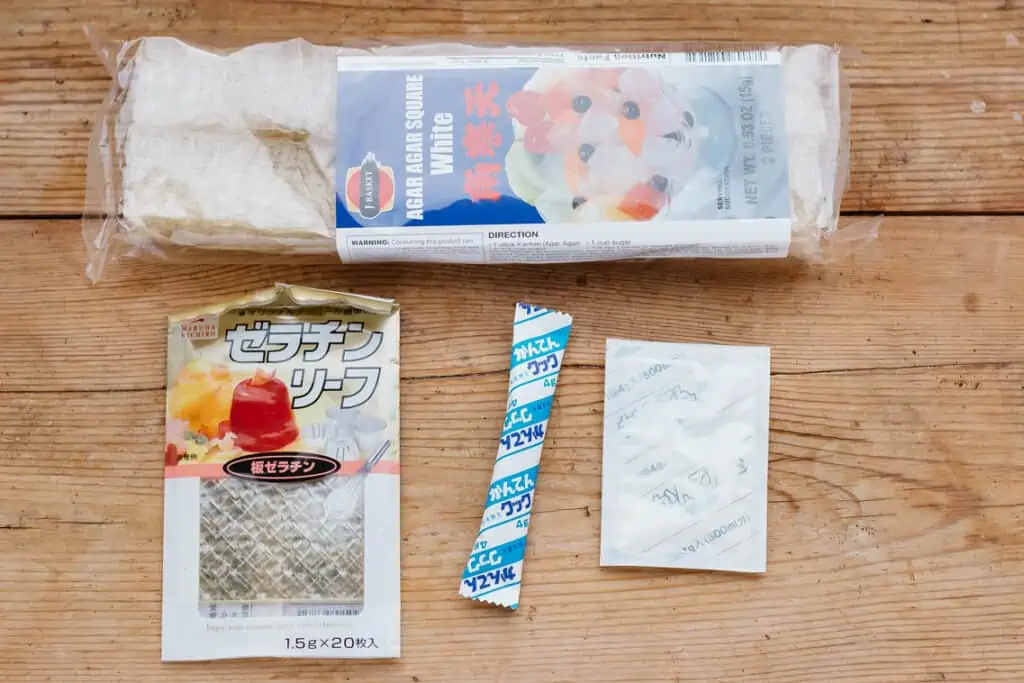
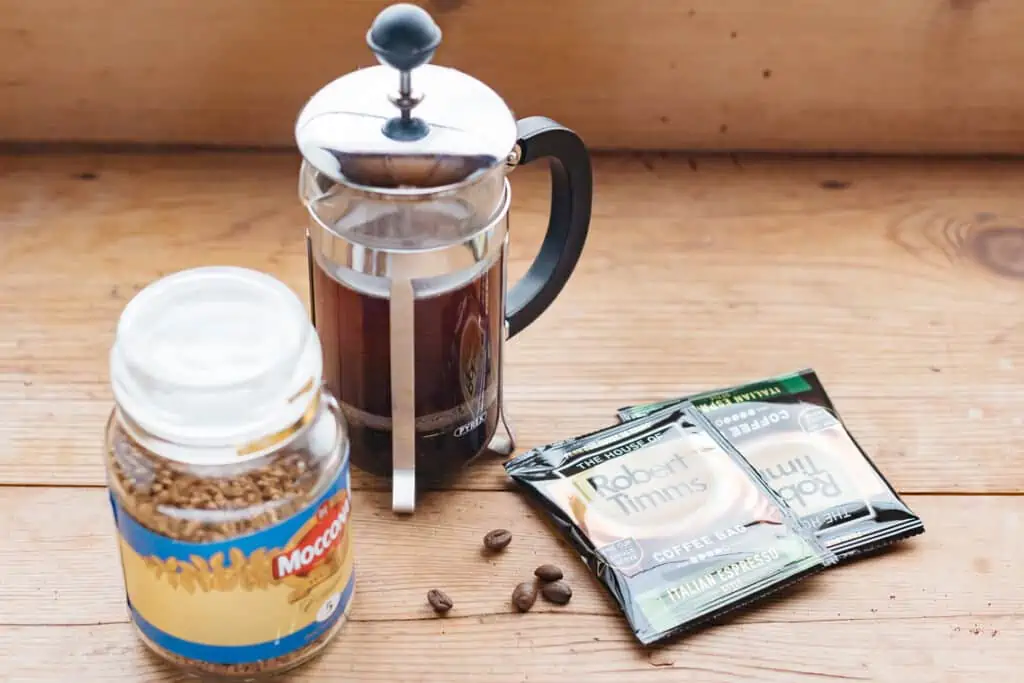



Made this as a dessert for dinner guests and it was loved by all.
Thank you Richard, I am glad that was a hit 😀
So excited to see a recipe for coffee jelly! Just watched an anime series where the main character loves coffee jelly and every time I watched it I wondered how it tastes.
I don’t see the instructions for using gelatin powder instead of kanten. How much gelatin do I use and when do I add it?
Thanks for the wonderful recipes!